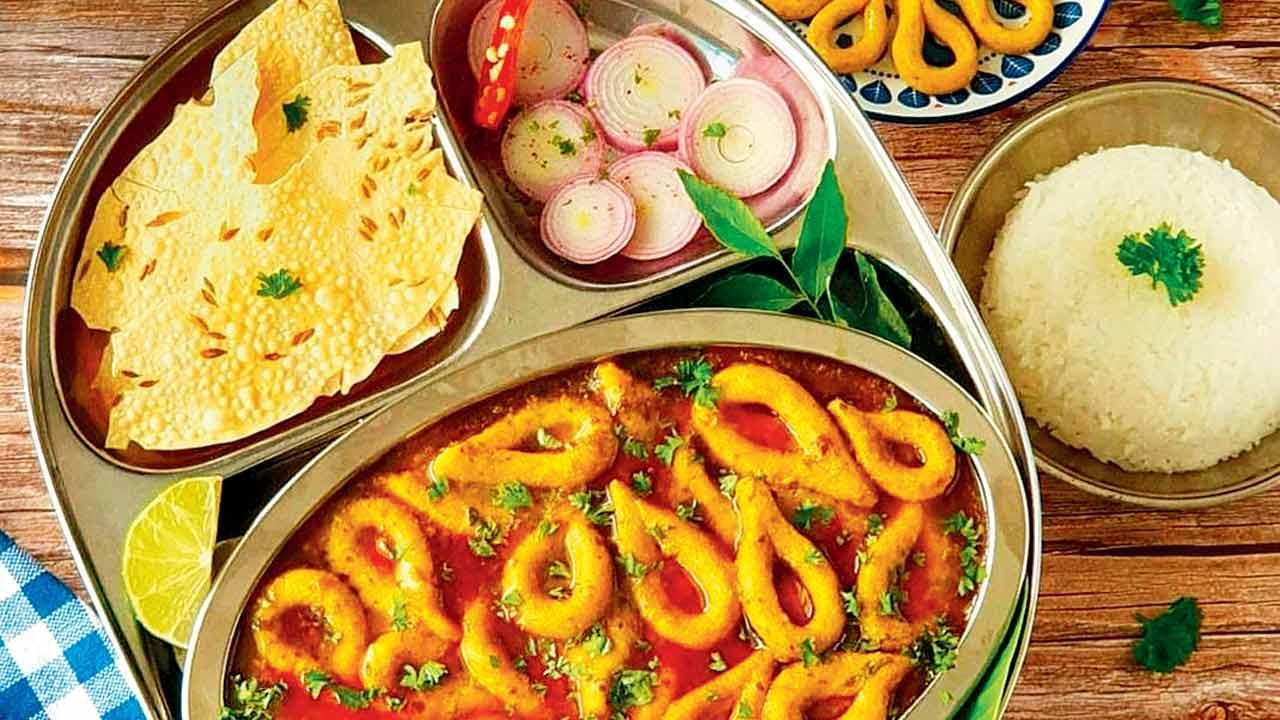Italians may be known as the masters of the pasta, but as Indians always say, “we have our age-old version, too”

It is cooked as hot and spicy pasta soup, with papad on the side
Maharashtrian cuisine is often viewed myopically. We are all familiar with, and have enjoyed, Malwani and Kolhapuri delicacies. However, beyond the known, there are several regions that have their own unique specialities. For instance, did you know that Raigad, Latur, Ratnagiri and Sindhudurg are home to indigenous forms of pasta, that have absolutely no connection to Tuscany? We meet food bloggers and home chefs for a peek into this gastronomical history.
ADVERTISEMENT
Shengole, from Marathwada and Vidarbha
Vaidehi Girish Rao
Vaidehi Girish Rao, a Singapore-based food blogger, originally from Kolhapur, finds cooking therapeutic. It is food that has kept her connected to her roots. “The shengole or ukad shengole is akin to a hot and spicy pasta soup. It originates from Marathwada and Vidarbha, and doesn’t need exotic ingredients to whip up,” says Rao who has lived in Singapore for over 10 years now. The dough is made with jowar, wheat flour and besan. It is then shaped into a tear drop. Garlic and green chillies are added to amp up the spice levels.
The shengole is a tear drop-shaped pasta made of jowar, wheat flour and besan
The dumplings are cooked straight in a simmering broth flavoured with red chilli powder and turmeric. Rao recounts the days when she would go to her grandmother’s house in Latur for the holidays and aaji’s shengole used to be the most awaited meal of the year. A large vessel full of shengole would be prepared, and the grandchildren would gather around the pot. “Not only would we participate in shaping the dough in the traditional tear drop style, but we also made our own shapes.” Since this pasta is a one pot meal, it doesn’t take long to prepare and is quite filling. One can enjoy the dish with a dash of lemon and ghee on top and papad on the side. “It tastes heavenly, especially on cold winter nights or on rainy days.”
Gavhale Kheer, across the state
The dough is shaped like gahu, a type of wheat grain
A chartered accountant by profession, Amarendra Balchandra Mulye is promoting Maharashtrian cuisine by dredging up old recipes. Gavhale kheer being one. “Indian festivities have a tradition of preparing foods that mark some significance with a ritual. Gavhale is one such item that has great significance in weddings and thread ceremonies. In fact, making it was an occasion in itself,” he says.
The creamy kheer is the most popular item made with gavhale. Mulye says you can substitute milk and sugar with condensed milk to make it richer
Gavhale is made from maida or a mix of fine semolina and maida and is believed to have been named after a wheat grain known as gahu. It is also known as valvat in some parts of Maharashtra. “As per my knowledge, there are five types of gavhale—gavhale, maaltya, fanole, mohor and nakhole. These pastas get their names from their shapes, much like the Italian pasta.
Ready to serve gavhlyanchi kheer
They were prepared ahead of ceremonies and were displayed as rukhwat [the showcase of a bride’s talents in front of her in-laws]. During Maharashtrian weddings, all these five types of gavhale were stored in glass containers and given to the bride, so that she could prepare instant kheer for guests during the first few days at her new home.” The most popular dish made with gavhale is kheer.
Amarendra Balchandra Mulye
Cooked in milk and sugar and topped with cardamom powder, nutmeg powder, saffron and dried fruits, the dish is offered to goddess Gauri as naivedya during Ganesh Chaturthi. Mulye says you can substitute milk and sugar with condensed milk to make it richer. A healthier version can be made by substituting sugar with stevia and using low fat milk.
Saravle, from coastal Maharashtra
Saher Khanzada
Saher Khanzada, founder of the Bombay Glutton blog and co-founder of the Khandaan’s Kitchen, belongs to the Konkani Muslim community. The ethnic sect inhabits the coastal stretches of Mumbai, Thane, Raigad, Ratnagiri and Sindhudurg districts of Maharashtra. “The community emerged as an outcome of intermingling of the local population with the Arab traders who flocked western India for trade.
Saravle dough is woven around a sirkand or stick
Hence, the cuisine is a beautiful mélange of native Maharashtrian and the Middle Eastern culinary styles. And, it’s true that we Konkani Muslims love pasta,” explains Khanzada. A popular one is the saravle or miniature, ring-shaped wheat pasta. “Traditionally, wheat was ground into flour using grinding stones at home and the flour was obtained by sifting the coarse flour multiple times.
The sweet saravle
The dough would then be stretched out by hand into thick threads and then woven around a light-weighted wooden stick called sirkand and allowed to dry in the summer sun until hard,” she explains. This dehydration process would shrink the dough, causing the threads to easily come off the stick as rings. Saravle is cooked in both, the savoury style with mutton or chicken with a dash of coconut milk, and as dessert, infused with green cardamom powder, sugar and a pinch of salt.
The savoury chicken saravle
Eggs are added in a final flourish, after which the dish is garnished with dry fruits and poppy seeds. The Middle Eastern culinary influence in the tradition of saravle is evident in the way the recipes use egg and meat. The sweet version is relished more in the community as a breakfast item and the savoury one for main course. To date, this pasta is not available at online grocery stores and shops and continues to be made by hand in homes.
 Subscribe today by clicking the link and stay updated with the latest news!" Click here!
Subscribe today by clicking the link and stay updated with the latest news!" Click here!







